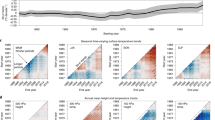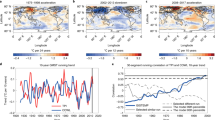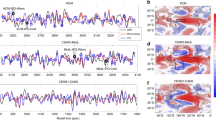Abstract
The tropical belt has widened by several degrees latitude since 1979, as evidenced by shifts in atmospheric circulation and climate zones1,2,3,4,5. Global climate models also simulate tropical belt widening, but less so than observed6,7. Reasons for this discrepancy and the mechanisms driving the expansion are uncertain. Here we analyse multidecadal variability in tropical belt width since 1950 using the Coupled Model Intercomparison Project Phase 5 climate model runs and find that simulated rates of tropical expansion over the past 30 years—particularly in the Northern Hemisphere—are in better agreement with observations than previous models. We find that models driven by observed sea surface temperatures over this interval yield the largest rate of tropical expansion. We link the tropical expansion in the Northern Hemisphere to the leading pattern of sea surface temperature variability in the North Pacific, the Pacific Decadal Oscillation. We also find, both from models and observations, that the tropical belt contracted in the Northern Hemisphere from 1950 to 1979, coincident with the reversal of the Pacific Decadal Oscillation trend. In both time periods, anthropogenic aerosols act to modify the Pacific Decadal Oscillation and therefore contribute to the width of the tropical belt. We conclude that tropical expansion and contraction are influenced by multidecadal sea surface temperature variability associated with both the Pacific Decadal Oscillation and anthropogenic aerosols.
This is a preview of subscription content, access via your institution
Access options
Subscribe to this journal
Receive 12 print issues and online access
$259.00 per year
only $21.58 per issue
Buy this article
- Purchase on Springer Link
- Instant access to full article PDF
Prices may be subject to local taxes which are calculated during checkout




Similar content being viewed by others
References
Seidel, D. J., Fu, Q., Randel, W. J. & Reichler, T. J. Widening of the tropical belt in a changing climate. Nature Geosci. 1, 21–24 (2008).
Hu, Y. & Fu, Q. Observed poleward expansion of the Hadley circulation since 1979. Atmos. Chem. Phys. 7, 5229–5236 (2007).
Archer, C. L. & Caldeira, K. Historical trends in the jet streams. Geophys. Res. Lett. 35, L0880 (2008).
Zhou, Y. P., Xu, K-M., Sud, Y. C. & Betts, A. K. Recent trends of the tropical hydrological cycle inferred from global precipitation climatology project and international satellite cloud climatology project data. J. Geophys. Res. 116, D09101 (2011).
Bender, F., Ramanathan, V. & Tselioudis, G. Changes in extratropical storm track cloudiness 1983–2008: Observational support for a poleward shift. Clim. Dynam. 38, 2037–2053 (2012).
Johanson, C. M. & Fu, Q. Hadley cell widening: Model simulations versus observations. J. Clim. 22, 2713–2725 (2009).
Allen, R. J., Sherwood, S. C., Norris, J. R. & Zender, C. S. Recent Northern Hemisphere tropical expansion primarily driven by black carbon and tropospheric ozone. Nature 485, 350–354 (2012).
Lu, J., Deser, C. & Reichler, T. Cause of the widening of the tropical belt since 1958. Geophys. Res. Lett. 36, L03803 (2009).
Held, I. & Hou, A. Nonlinear axially symmetric circulations in a nearly inviscid atmosphere. J. Clim. 37, 515–533 (1980).
Lu, J., Vecchi, G. A. & Reichler, T. Expansion of the Hadley cell under global warming. Geophys. Res. Lett. 34, L06805 (2007).
Polvani, L. M., Waugh, D. W., Correa, G. J. P. & Son, S-W. Stratospheric ozone depletion: The main driver of twentieth-century atmospheric circulation changes in the Southern Hemisphere. J. Clim. 24, 795–812 (2011).
Allen, R. J., Sherwood, S. C., Norris, J. R. & Zender, C. S. The equilibrium response to idealized thermal forcings in a comprehensive GCM: Implications for recent tropical expansion. Atmos. Chem. Phys. 12, 4795–4816 (2012).
Taylor, K. E., Stouffer, R. J. & Meehl, G. A. An overview of CMIP5 and the experimental design. Bull. Amer. Meteorol. Soc. 93, 485–498 (2012).
Mantua, N. J., Hare, S. R., Zhang, Y., Wallace, J. M. & Francis, R. C. A Pacific interdecadal climate oscillation with impacts on salmon production. Bull. Am. Meteorol. Soc. 78, 1069–1079 (1997).
Deser, C., Alexander, M. A., Xie, S. P. & Phillips, A. S. Sea surface temperature variability: Patterns and mechanisms. Annu. Rev. Mar. Sci. 2, 114–143 (2010).
Pierce, D. W. Distinguishing coupled ocean–atmosphere interactions from background noise in the North Pacific. Prog. Oceanogr. 49, 331–352 (2001).
Newman, M., Compo, G. P. & Alexander, M. A. ENSO-forced variability of the Pacific decadal oscillation. J. Clim. 16, 3853–3857 (2003).
Schneider, N. & Cornuelle, B. D. The forcing of the Pacific decadal oscillation. J. Clim. 18, 4355–4373 (2005).
Lu, J., Chen, G. & Frierson, D. M. W. Response of the zonal mean atmospheric circulation to El Niño versus global warming. J. Clim. 21, 5835–5851 (2008).
Grassi, B., Redaelli, G., Canziani, P. & Visconti, G. Effects of the PDO phase on the tropical belt width. J. Clim. 25, 3282–3290 (2012).
Neale, R. B. et al. Description of the NCAR Community Atmosphere Model (CAM 5.0). Tech. Report NCAR/TN-486+STR (National Center for Atmospheric Research, 2012)
Allen, R. J., Norris, J. R. & Wild, M. Evaluation of multidecadal variability in CMIP5 surface solar radiation and inferred underestimation of aerosol direct effects over Europe, China, Japan and India. J. Geophys. Res. 118, 6311–6336 (2013).
Bond, T. C. et al. Bounding the role of black carbon in the climate system: A scientific assessment. J. Geophys. Res. 118, 5380–5552 (2013).
Adler, R. et al. The version-2 Global Precipitation Climatology Project (GPCP) monthly precipitation analysis (1979–present). J. Hydrometeor. 4, 1147–1167 (2003).
Kalnay, E. et al. The NCEP/NCAR 40-year reanalysis project. Bull. Am. Meteorol. Soc. 77, 437–471 (1996).
Kanamitsu, M. et al. NCEP-DOE AMIP-II Reanalysis (R-2). Bull. Am. Meteorol. Soc. 83, 1631–1643 (2002).
Rienecker, M. M. et al. MERRA: NASA’s modern-era retrospective analysis for research and applications. J. Clim. 24, 3624–3648 (2011).
Saha, S. et al. The NCEP climate forecast system reanalysis. Bull. Am. Meteorol. Soc. 91, 1015–1057 (2010).
Compo, G. et al. The twentieth century reanalysis project. Q. J. R. Meteor. Soc. 137, 1–28 (2011).
Yu, L. & Weller, R. A. Objectively analyzed air–sea heat fluxes for the global ice-free oceans (1981–2005). Bull. Am. Meteor. Soc. 88, 527–539 (2007).
Acknowledgements
This study was financially supported by NASA grant number NNX13AC06G. We acknowledge the WCRP’s Working Group on Coupled Modelling, which is responsible for CMIP, and we thank the climate modelling groups for producing and making available their model output. For CMIP the U.S. DOE’s Program for Climate Model Diagnosis and Intercomparison provides coordinating support and led development of software infrastructure in partnership with the Global Organization for Earth System Science Portals.
Author information
Authors and Affiliations
Contributions
R.J.A. conceived the project, designed the study, carried out most of the data analysis and wrote the manuscript. J.R.N. advised on methods and interpretation, and assisted in the writing of the manuscript. M.K. assisted with data analysis.
Corresponding author
Ethics declarations
Competing interests
The authors declare no competing financial interests.
Supplementary information
Supplementary Information
Supplementary Information (PDF 12888 kb)
Rights and permissions
About this article
Cite this article
Allen, R., Norris, J. & Kovilakam, M. Influence of anthropogenic aerosols and the Pacific Decadal Oscillation on tropical belt width. Nature Geosci 7, 270–274 (2014). https://doi.org/10.1038/ngeo2091
Received:
Accepted:
Published:
Issue Date:
DOI: https://doi.org/10.1038/ngeo2091
This article is cited by
-
Spatio-temporal correspondence of aerosol optical depth between CMIP6 simulations and MODIS retrievals over India
Environmental Science and Pollution Research (2024)
-
Atmospheric trends explained by changes in frequency of short-term circulation patterns
Communications Earth & Environment (2023)
-
Hadley circulation dynamics in the IITM-Earth System Model simulations: evaluation and future projections
Theoretical and Applied Climatology (2023)
-
Variability and changes to the mean meridional circulation in isentropic coordinates
Climate Dynamics (2022)
-
Reassessing the relative role of anthropogenic aerosols and natural decadal variability in driving the mid-twentieth century global “cooling”: a focus on the latitudinal gradient of tropospheric temperature
Climate Dynamics (2022)



